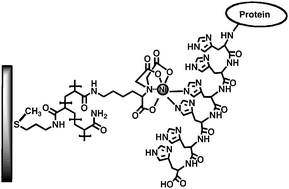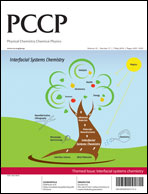We describe a modified bifunctional analogue of polyacrylamide that spontaneously forms self-assembled polymeric thin films on Au surfaces. The film is engineered to specifically bind histidine tagged proteins (6His), while simultaneously remaining inherently resistant to the non-specific adsorption of proteins in solution. The backbone of a polyacrylamide-co-n-acryloxysuccinimide copolymer is functionalized via tandem active ester (NHS) couplings with 3-(methylthio)propylamine (MTP) and nitrilotriacetic acid (NTA). The resulting functionalized polymers form stable and exceptionally hydrophilic thin films that are ∼2–5 nm thick, a mass coverage that varies with the MTP graft density. These films are characterized using a variety of techniques (X-ray photoelectron spectroscopy (XPS), reflection absorption infrared spectroscopy (RAIRS), ellipsometry, surface plasmon resonance (SPR), and matrix assisted laser desorption ionization (MALDI)) to establish their structure and function. The protein resistance of the films, as demonstrated by their exposure to solutions of bovine serum albumin (BSA), can be modulated by the amount of MTP grafted to the polymer, which in turn, affects their mass coverage. We show that it is possible to specifically capture hexahistidine tagged proteins with low incidences of nonspecific adsorption using these materials, a discrimination quantified using surface plasmon resonance (SPR) at concentrations down to ∼20 nM. These polymers also bind strongly to the surfaces of Au nanoparticles, stabilizing them against aggregation, providing them with a similar capacity to selectively bind 6His tagged proteins that can then be speciated using MALDI.

You have access to this article
 Please wait while we load your content...
Something went wrong. Try again?
Please wait while we load your content...
Something went wrong. Try again?


 Please wait while we load your content...
Please wait while we load your content...